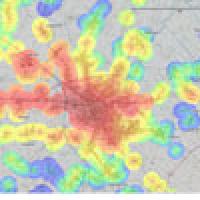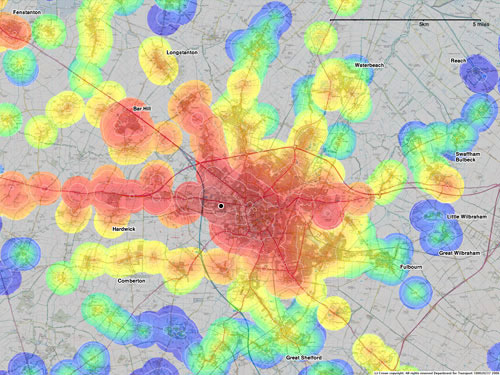
Travel-time maps - transforming our view of transport
Do you want to come and say hello to Plus but are wondering how you should get here? Then take a look at this map of Cambridge and its surrounds — the transition of colours from warm red to cool violet indicates how long it will take you to get to the Plus office, situated in west Cambridge, at 9am using public transport. At a glance you can see the well connected areas bathed in red, and the uncoloured areas from which you won't be able to make the journey on public transport at all.

© Crown copyright. All rights reserved. Department for Transport 100020237 2006
This is an example of the spectacular travel-time maps produced by mySociety, in work funded by the Department for Transport. Frank Kelly, from Cambridge University, has just finished his time as Chief Scientific Adviser to the Department of Transport: "The travel-time maps are an early example of how data, in this case the data that has been put together for TransportDirect, a real-time information service, can be used to do things which have other influences, in this case long-term locational influences on the transport system. By providing information in digestible forms like this we might be able to encourage the use of public transport and influence directional policy."
Chris Lightfoot, from mySociety, used existing datasets which were collected for other purposes — the databases of timetable information and transport service connections from TransportDirect, and the locational information from postcodes — to produce the maps:
"Clearly the travel-time for a particular journey [depends on] the origin and destination points, the time of travel, the modes used, and of decisions made by the traveller (for instance whether to prefer faster or cheaper journeys). Our travel-time maps can only conveniently [take account of] one of these points (the origin or destination point), so we need to fix the others so that the maps describe journey times which are useful to users in some context, and are practical to compute.
"We view the work the Department of Transport and TransportDirect have done as a sort of black box. We feed very large numbers of queries into the journey planner at TransportDirect (approximately 30,000) and use those to form an estimate of the travel time. For maps such as the one above, we fix the destination and arrival deadline and iterate over all the transport interchanges in the region of interest to compute the latest departure necessary to arrive before the deadline.
"Now we have enough information to draw the map. We iterate over a grid of points in the region of interest (choosing the spacing by the resolution of the map to be drawn); at each point we search for transport interchanges within 15 minutes' walking distance of that point, and choose the one which gives the shortest overall journey time, if any. This generates a grid of points at which we know the journey time, or know that no journey is possible. From this it is trivial to draw a map where each point is coloured according to journey time, or uncoloured if no journey is possible."
The map above is so easy to interpret visually because the colours are easily differentiated and because they are separated by clear and smooth contour lines. Both these features don't arise naturally from the process just described and some mathematical smoothing out is needed. A sophisticated process called histogram equalisation adjusts the colour of each pixel to ensure that the colours are distributed for optimal contrast. "Drawing the contours," says Lightfoot, "is slightly more subtle, because the function to contour — the travel-time — is not actually defined everywhere in the region of interest. We fix this up by extrapolating the values of the travel time outside the domain of the function, contouring the extrapolated function, and then clipping the contours against the domain of the function." The extrapolation is actually a solution to Laplace's equation, a differential equation ubiquitous in many areas of physics, from electromagnetism to fluid dynamics.
"The map above shows the travel-time from locations in Cambridge and the surrounding villages to reach west Cambridge (the small black circle near the centre) by 9am. The contour lines are drawn at intervals of 10 minutes, so that the innermost contour around the destination corresponds to a start time of about ten to nine.
"Cambridge is a small city with a lot of bus services, so it is not very surprising that the whole of the city centre and much of the suburbs are within twenty to thirty minutes' travel of the destination, even including waiting and walking time. Moving further out, though, the picture changes. Areas connected to Cambridge by fast roads such as the A14 fare much better than those villages off the beaten track. For some habitations (such as Rampton, to the north-east of Longstanton, in an uncoloured area of the map) it is not possible to reach the West Cambridge Site for 9 o'clock purely by public transport without a long walk or an overnight journey.
"Some of the results are quite surprising. For example I hadn't realised how poorly connected some of the satellite villages around Cambridge are."
The hope is that the travel-time maps can offer people an easy way to make decisions about where to live, and work, and travel to, that may encourage the use of the public transport system. Other travel-time maps also compare travel by car to public transport, and future work may link transport to house prices to give some insight into an aspect of social deprivation.
The contours in the travel-time maps are known as isochrones, from the Greek iso, meaning "equal" and chronos, meaning time. Isochrones were first calculated by Francis Galton in the 19th century, in an early application of dynamic programming, to the determine routes for sailing boats. "The major issues in more recent years have concerned the organisation of, and access to, data of fine granularity in space and time," says Kelly. An underlying purpose of the work is to tackle the question of access to data. The maps of mySociety were produced under the auspices of the Department of Transport, so they did not have to pay for the use of expensive datasets such as postcodes and the Ordnance Survey maps. The work has raised questions about who owns the data, who can access it and how easily it can be interchanged and the maps reproduced.
Frank Kelly says that the maps are more than just pretty to look at: they also demonstrate an innovative way to use and present existing data. "We are entering a world where there are vast quantities of data, and any way you can find of turning that data into information, which will often involve clever ideas about visualisation, will become more and more important in science, government, and our daily lives."
Further information
You can read more about the travel-time maps at mySociety — a charitable project that builds websites that help people to get involved in civic and community activities. And some wider issues concerning innovative uses of transport data are discussed in a recent article by Frank Kelly.